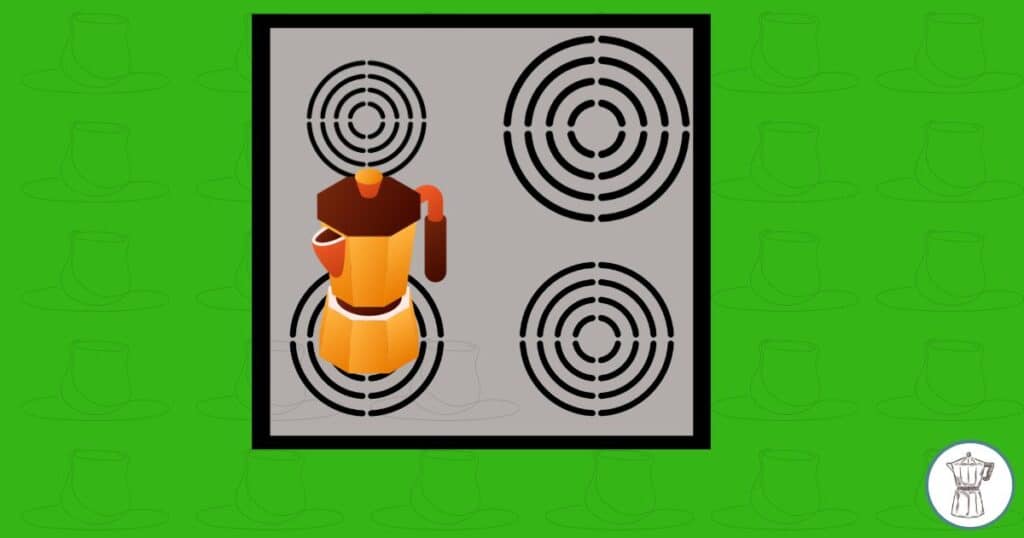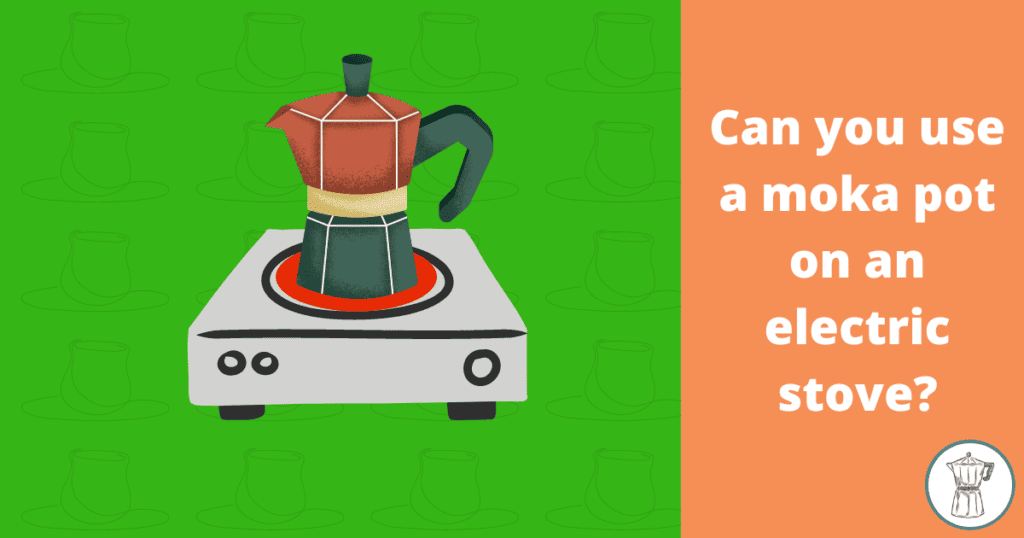Ever wondered ‘Can you use a Moka pot on an electric stove?’
The other day I just wanted to use my Moka pot to brew coffee and caught myself thinking that. So, I went online to read and watch material related to this topic and interestingly, I found a number of interesting things I’d like to share with you.
Let’s dive in.
Key takeaways:
- The material of Moka pots
- The benefits of using a Moka pot on an electric stove
- All the different types of electric stoves and their features
Can you use a Moka pot on an electric stove?
Yes, you use an electric stove when brewing coffee with a Moka pot. Ideally, the level of heat should be medium to make sure you don’t overheat it and spill coffee all over your kitchen, but at the same time, you need enough heat to brew the coffee.
What you should know about Moka pots made of aluminium
The vast majority of espresso machines are made of stainless steel. But, typically, Moka pots are made of aluminium for a good reason.
Here’s why aluminium is used as the main material:
Aluminium is an excellent material for Moka pots; unlike stainless steel, it gets heated quickly and transfers this heat evenly, meaning that the water used for brewing will extract the flavours and aromas of your coffee grounds to make delicious coffee for you. Plus, coffee grounds don’t easily stick to aluminium (unless you overheat coffee) which always makes it easy to clean it.
Another important factor about aluminium is that it easily oxidises when washed with water and it might lose its bright colour. For this reason, it’s wise to put your Moka pot in your dishwasher and it’s better to rinse it and dry it right after with a kitchen roll.
Using an electric stove for brewing with a Moka pot
Electric stoves are used for cooking, boiling water or even brewing with a Moka pot.
They usually come in different heat powers and levels but almost all of them have a low, medium and strong heating level. When you brew coffee it’s wise to use a medium level of power. If you use the low it won’t brew as the Moka pot needs to build up pressure inside so the water can extract the flavours and aromas from the coffee grounds. If you use the strong level, the chances are you’ll burn your coffee and it will turn bitter.
Some of the benefits of using electric stoves are:
- They are typically less expensive compared to gas stoves
- They are more precise, easier and safer to use
- You control the heat you need each time better
Here’s what a barista trainer says about a Moka pot on an electric stove:
It will take a bit longer than a gas cooker, and I would heat up the stove plate before placing the Moka Pot on it to avoid heating up the coffee grounds too much while the stove plate gains heat. Using warm water in the pot also helps prevent the grounds heating up too much before the brewing process begins.
– Chris Pefanis
Types of an electric stove
Let’s go over all the different types of electric stoves so you have a better understanding of which one suits you best.
1. Induction
Here are the main benefits of induction stoves:
- Energy-efficient: They use a magnetic field to heat the metallic containers you put on top of them. Because they only transfer heat to the pots and pants they are pretty energy-efficient.
- They adapt quickly to changes: Another important benefit of using such stoves is that they change temperature pretty quickly. If you want to turn down the heat, it’s going to happen in a matter of seconds.
- Safety features: because they have safety features embedded they are safer to use than other stove types including gas or other electric stoves.
- Safer to use: if you forget the stove on induction stoves are designed in a way to avoid accidents and therefore are overall safe to use.
2. Coil
It’s no surprise that these are probably the most popular types of stoves as they are durable easy to use and you can find endless options.
Here’s how a coil stove works:
The coil gets warmed by an electrical current and the heat is transferred from the coil to the pots and pans.
They are pretty efficient as they produce heat really quickly, but you need to be careful when you use them, if the food or coffee spills over the stove it’s relatively tough to remove the marks. If this happens to you let the stove cool down completely and then put a bit of water so the marks soak use a sponge (not the rough side) to make it easier to clean ti properly.

3. Infrared
Infrared radiation is a unique form of energy. This form of energy that we can’t really see with the naked eye; all it does is converts electrical energy to infrared radiation and then heat it to warm up the stove and subsequently your pot or pan.
Overall, they’re pretty easy to use and super efficient that’s why recently many opt for this kind of stove.
Here’s what a coffee lover says about different kinds of stoves:
I’ve found that every stove is different, but at the same time it doesn’t really affect the end result, as long as you adjust for it. I’ve lived in a dozen different places in the last 2 years, and each stove I’ve used is different. 2 were gas-lit stoves, my current one is electrical, and the others were electric-coil types. Each one was different in their temperature settings and speeds, so it takes a while to adjust to each one and see how they affect the moka pot. The gas one, for example, I would have to set it on as low as possible and that, I found, was equivalent to a medium heat on an electric stove top. Another apartment I lived in, I would set it on to number 8 (on a circular scale of 1-9) which was technically high heat, but it still percolated the coffee in 5 minutes so that was the end goal for me.
– maximus9966
4. Glass
Glass stoves are increasingly becoming popular for a good reason. The stovetop is made of tempered glass.
Here are the benefits of stoves made of glass:
- Appealing to the eye: many find them appealing to the eye as they look sleek and just have great design. Let’s be honest, design plays a role when we buy stuff, so why not go for glass stoves?
- Easy to clean: All you need to do is wipe them with a kitchen roll (when the stove has cooled down) or a wet cloth and this will be enough to remove any marks. They are designed in a way that makes cleaning super easy.
- Energy-efficient: They’re probably some of the most energy-efficient stoves you can find out there as manufacturers use cutting-edge technology.
5. Ceramic
These are some of the most reliable stoves on the market.
Here’s the way they work:
Electricity heat ceramic plates which transfer this heat to the pots and pans. They’re ideal for anyone who looks for a safe option to avoid accidents – if you have kids it’s wise to consider this option.
They’re also more lightweight which makes them an excellent option if you live in a small house. One of their main downsides is that it takes them a bit longer to heat up and cool down than other kinds of stoves.
How to use a Moka pot on an electric stove step by step
Let’s go over the steps you need to follow to make great coffee with a Moka pot.
The table summarises the steps that follow:
| Step1 | Preheat the electric stove to brew better coffee |
|---|---|
| Step2 | Put the right amount of water on the bottom of Moka pot |
| Step3 | Switch the stove on and keep it on until coffee is brewed |
| Step4 | Clean your Moka pot to have it ready for next time |
1. Preheat your electric stove
You’ve probably heard this before but it’s good to restate it once more.
Coffee is more of a science than an art.
That being said it’s key to doing the temperature right. One of the most important things to achieve this is to start by preheating your electric stove. This way the water will hit the right temperature faster. A good starting temperature is 30-40°C which you can achieve by turning the stove on for a couple of minutes.
2. Add water to your Moka pot
I can’t stretch the importance of the temperature enough.
It’s key to add warm water to your Moka pot so it starts brewing faster and it will hit the right temperature.
A great rule of thumb is to add 100ml of water of which 70% should be warm and 30% cold. And as we already know aluminium quickly and evenly transfers the heat to brew your coffee fast.
3. Τurn the electric stove on
Start with medium level so there’s going to be enough heat to brew coffee and at the same time, it won’t be too strong to burn your coffee. It’s a good idea to keep the top open and keep an eye on it. When it starts boiling, move the Moka pot to the edge of the stove so it won’t be heated much. Once the colour of the coffee that is flowing on the upper chamber becomes brighter in colour it’s time to lift your Moka pot off the stove.
4. Time for cleaning
This is the boring part.
After brewing it’s vital to clean your stove and Moka pot.
Here’s how to clean your Moka pot:
- Rinse it properly to remove any coffee residue
- Disassemble it to get rid of the used coffee grounds
- Use a kitchen roll to wipe it and put it back together
Here’s how to clean your electric stove:
- It’s important to let your stove cool down for about 35 minutes by the time you turn it off properly to avoid any injuries
- Dip a cloth in water and wipe it to remove any coffee marks
Let’s wrap it up
So can you use a Moka pot on an electric stove? That’s it for now, I hope this article helped you get a better understanding of how to brew better coffee with a Moka pot. After all, it’s all about experimentation and just getting better at brewing over time. Stay tuned, more articles to come.

- How to Remove Coffee Stains From Countertop The Easy Way - December 21, 2023
- Can You Reuse Coffee Grounds in French Press? Truth Inside - December 12, 2023
- Can Expired Coffee Creamer Make You Sick? 3 Ways to Find Out - December 9, 2023
